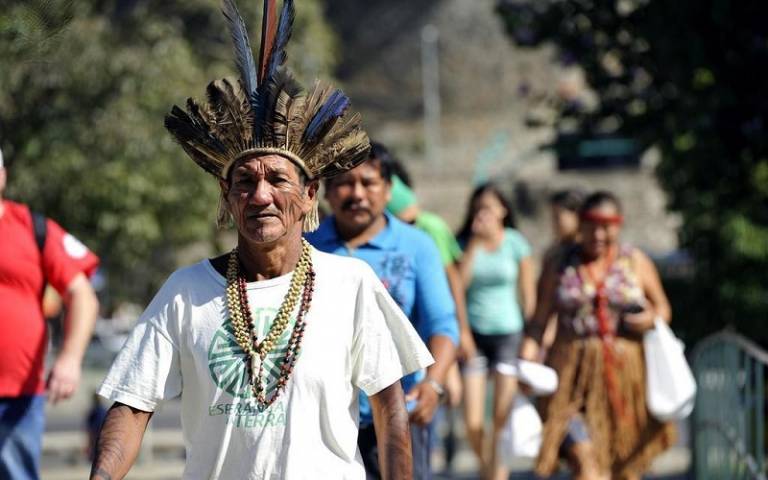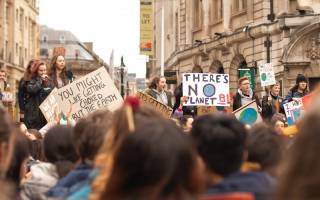Indigenous Peoples to the Rescue: Saving the UN Biodiversity and Climate Talks from Themselves
26 July 2021
Indigenous communities are at the frontline of the climate and biodiversity crisis yet they continue to be sidelined in global negotiations.

By Zoë Varenne (UCL Global Governance Institute)
Protecting and strengthening biodiversity is crucial to mitigating the worst impacts of the climate emergency. Historically, these two domains have too often been treated as separate concerns. But, as explored in a recent workshop hosted by the UCL Global Governance Institute, the two are inextricably tied together and policymakers are now urgently focused on how to surround them within a virtuous circle of protection. The stakes could not be higher. A 2019 landmark global biodiversity assessment showed that species and ecosystems are declining at rates “unprecedented in human history”. While addressing climate change remains an important priority, it is becoming increasingly clear that the prospect of mass biodiversity loss is just as catastrophic.
In addressing this challenge, the Intergovernmental Science-Policy Platform on Biodiversity and Ecosystem Services (IPBES) has highlighted the vital role of indigenous and local community knowledge in biodiversity and ecosystem preservation. While this observation will be nothing new to anthropologists, geographers, ethnographers and biologists, it has long been ignored within powerful policy circles – principally due to the challenge such knowledge poses to government economic policies premised on extractive industrial growth. Notably, only 18 percent of the World Bank’s conservation portfolio is allocated to indigenous peoples’ programmes. Most of the $800 million spent annually (estimated to be a shortfall of $1 to $1.7 billion per year) by international donors to support biodiversity conservation areas do not go to indigenous peoples but rather is spent on infrastructure and hiring outside administrators and specialists.
However, new research demonstrates conclusively that the land practices of traditional and indigenous peoples have historically helped sustain biodiversity. This stands in stark contrast to the colossal destruction wreaked by decades of intensive human development which now threatens to upend essential life support systems, including those we depend upon for global food security. Subject to systematic discrimination and worse, indigenous peoples today make up only six percent of the global population, yet they protect 80 percent of the biodiversity left in the world.
Indigenous peoples and local communities continue to be excluded from the top table at global negotiations on biodiversity loss. Indeed, as the Conference of State Parties (COP) to the Convention on Biological Diversity (CBD) gets ready to meet for crunch talks at the much delayed COP-15 biodiversity summit in Kunming, China, indigenous peoples are making their disquiet known regarding UN-backed policies that historically have often done more harm than good, even violating their rights through eviction from ancestral homelands.
This troubling reality belies a raft of international agreements which ostensibly enshrine indigenous people’s rights and recognise the value of customary knowledge. The CBD’s Aichi Target 18, agreed in 2010, places traditional knowledge front and centre when it comes to the Convention’s implementation. However, none of the Aichi Targets for 2020 have been fully met. The 2007 non-binding UN Declaration on the Rights of Indigenous Peoples (UNDRIP) reaffirms indigenous communities’ right to ‘free, prior and informed consent’, as also contained in the 1989 ILO Convention 169. However, Bolivia is the only country in the world to have formally incorporated both ILO 169 and the UNDRIP into national law, albeit with mixed results. And while many countries have signed ILO 169, the duty to ensure free, prior and informed consent for oil and gas exploration is routinely ignored.
Indigenous peoples have long been the canary in the mine when it comes to biodiversity destruction. The forces which are driving ecological destruction have also often posed an existential threat to this vulnerable group, with the disappearance of indigenous peoples correlated with biodiversity loss. According to Frontline Defenders, a majority of human rights defenders killed in 2020 were environmental, land and indigenous rights defenders. Many of those killed are located in Latin America where remote indigenous communities face regular incursions, threats and intimidation from corporate and state actors seeking to exploit their land and natural resources. In Brazil, President Jair Bolsonaro has torched environmental protections and with them huge swathes of the Amazon rainforest. Driven by the agribusiness lobby and global market forces, deforestation to make way for industrial beef and soy production has turned the world’s biggest terrestrial carbon sink into a net carbon emitter. The consequences of large scale Amazonian deforestation on, for example, rainfall from Mexico to Texas, are only just beginning to be understood.
However, there are also more insidious ways in which indigenous peoples are impacted by government action. In particular, where conservation areas often encroach onto indigenous lands, government protection orders have resulted in the eviction of indigenous communities. Since 2017, more than 250,000 indigenous and local persons in 15 countries have been evicted from protected areas. Failure by government to acknowledge the formal territorial rights of indigenous peoples to their ancestral land results in frequent conflict between these communities and state actors. In India, for example, 70 percent of the conservation budget goes toward tiger conservation zones and the Forest Rights Act, which is intended to facilitate rights claims by indigenous peoples to land and forest use, is often rejected in tiger reserves. Such tensions raise a host of thorny issues which are not easily resolved. It is important to not romanticise traditional and indigenous peoples or perpetuate the myth of “untouched habitats”. Some early land use practices were also associated with extinction. Nevertheless, the historical record shows that indigenous peoples, perhaps having learnt from past mistakes, have historically helped to sustain biodiversity.
The devastating impact of systematic discrimination against indigenous peoples is borne out across human wellbeing metrics. While making up five percent of the world population, indigenous persons account for 15 percent of the extreme global poor and their life expectancy is 20 years below that of non-indigenous persons. Large-scale development projects have resulted in indigenous peoples becoming internally displaced, such as the Biloxi-Chitimacha-Choctaw tribe in Louisiana or the Inupiaq whaling community of Kivalina. When the Sengwer people in Kenya were forcibly evicted from their ancestral land without consent to make way for internationally funded conservation areas, no compensation or assistance with relocation was forthcoming.
Over 30 years of UN climate change and biodiversity talks have not impeded “nature’s dangerous decline”. On the contrary, during this time, governments have presided over record increases in CO2 emissions and species extinction, trends which show no signs of abating. Nevertheless, it is clear that momentum is growing for pushing back on what is considered acceptable when it comes to responding to an accelerating crisis. As the Intergovernmental Panel on Climate Change made clear in 2018, an adequate policy response requires nothing less than “rapid, far-reaching and unprecedented changes in all aspects of society”. It is clear that the perspective of indigenous peoples has much to teach us when it comes to sustaining biodiversity over millennia. The question is whether at this late hour, the prevailing orthodoxies of industrial civilization can make room for indigenous common sense. As the native American proverb goes:
“Treat the earth well: it was not given to you by your parents, it was loaned to you by your children. We do not inherit the Earth from our Ancestors, we borrow it from our Children.”
 Close
Close


